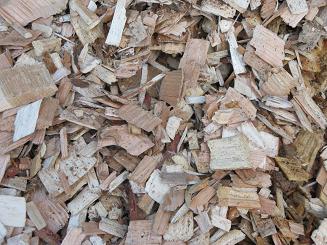B. Jackson, R. Schroeder, S. Ashton, and EL Taylor
Chippers are machines that cut material with a slicing action. They make up most of the woody biomass size-reduction equipment in use today and are characterized by high output, high speed cutting knives. Most chippers have the capacity to blow chips into transport trailers for hauling. They rely on sharp knives and unfortunately are susceptible to knife wear from high soil content, metal contamination, rocks and stone. Chippers are well integrated into existing timber harvesting systems.

Chippers are customarily placed either off-road, at the timber harvest landing, or on-site at the mill or plant. Chippers placed at the landing are often mounted on trucks. This system and direct loading of custom chip vehicles can be a highly sensitive system because the material being shipped is costly due to moisture content. Chipping relies on the smooth functioning of all steps in the woody biomass supply chain. Downtime is costly when a delay occurs at the chipper, on the truck or at the facility. This problem is greatest when a container system or custom chip vehicle is used. Off-road woody biomass chipping is an alternative system. Piles of logging residues left by the harvester or feller/buncher are chipped in late summer or early autumn at the logging site. This system is used to moderate the supply of wood chips during periods of low demand. It produces high quality biomass at a competitive cost because the biomass is allowed time to dry. Off-road woody biomass chipping is not practiced very much in the Southeastern United States because it is a capital-intensive, two-pass system that is high in operational and transportation costs. It may, however, provide a niche opportunity for independent contractors, separate from the conventional harvest, specializing in the recovery of woody biomass.
Use of a large mobile or stationary woody biomass chipper or crusher at the heating plant is another option. This method can save two-thirds of the cost associated with conventional off-road chipping at the logging site because of economies of scale and powerful equipment can be used. Offsetting the advantages are increased noise levels at the plant and the need for storage of uncomminuted woody biomass.
Chipping independently or alongside a round-wood operation — utilizing the non-merchantable debris (tops and slash) for chips — involves a chipper, another loader, another man and trailers and costs $18 per ton plus the $14 per ton in 2009 dollars for felling, delimbing and loading. Total cost for logging and transporting non-merchantable chips within 60 miles, or 111 kilometers, from a tandem merchantable/non-merchantable logging operation is $32 per ton. The biggest reason for the increased cost of chipping is cost of equipment. A chipper costs $500,000, chip vans cost $30,000 each, versus pole trailers at $2,000 each, another loader cost $125,000.00. Chipper maintenance is higher than regular logging, as the knives or blades have to be changed out pretty frequently. Additionally, most wood burning electric providers require a moisture content of 50 percent or less, which reduces net payload weights even with a full load of chips. If these bio-energy plants do start paying the $32 per ton, they may acquire much of chipped merch wood traditionally destined for oriented strand board (OSB) and paper mills that are only paying $22-25 per ton delivered.
If chipping is performed in or near the landing, there are a number of negatives. Storage is negatively affected. Independent studies of in-woods chipping in East Texas suggest that maximum storage time is approximately 60 days. Once material is chipped, it is important to use the fuel as soon as possible to prevent excessive energy value loss from microbial activity and the risk of self-ignition from storing green chips (Johansson et al. 2006)]]. However, depending upon time of year the material is harvested. Past that, energy value is significantly reduced. Chipping costs for loose residue at or near the harvest site are higher than chipping bundles at either a terminal or power plant. Chipping/grinding costs are reduced by 65 percent at a centralized facility with parasitic load.
Refererences
- Johansson J, Liss J, Gullberg T, Bjorheden R. 2006. Transport and handling of forest energy bundles – advantages and problems. Biomass and Bioenergy 30:334-341.
